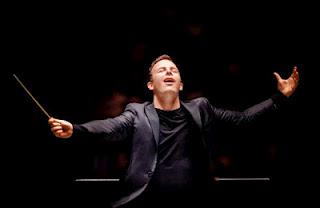by Paul J. Pelkonen

Trouble shooter: Yannick Nézet-Séguin.
Photo by Marco Borggreve © 2012 YannickNézet-Séguin.com
Although Haydn an Beethoven knew each other and follow each other in the historical procession of great Vienna-based composers, these two works could be tied together by their common origin in a Europe beset by crisis and war. Beethoven's Symphony No. 2 (written in 1801) is filled with revolutionary spirit, an optimistic, yet dramatic pinnacle of Beethoven's early style. The Mass is much darker, the sound of Austro-Hungarian aristocracy fretting in the midst of the Napoleonic Wars.
Working with the larger Festival Orchestra, Mr. Nézet-Séguin led a Second Symphony that bristled with energy and good humor. After an appropriately slow, dramatic buildup, the rapid-fire main theme of the opening movement leapt out of the starting gate, driven hard by the young conductor. The slower second movement went at a fairly brisk pace, with lovely textures from the bassoons and horns.
The Scherzo was full of rhythmic vitality, with the rustic second theme seeming to guffaw as it depicted a countryside celebration. This is the blueprint for that other famous dance movement: the "Merry Gathering of Country Folk" from the composer's Sixth, the Pastorale. The finale, with its chortling opening chords, was taken at the fastest possible speed, but Beethoven's harmonic ideas were still expressed clearly and coherently.
The Nelson Mass (the composer originally titled the work Missa in Angustiis or "Mass for Troubled Times") is one of Haydn's most potent sacred compositions, combining the power of his sturm und drang symphonies with the skilled choral writing that pervades his popular oratorios The Creation and The Seasons. The work has enjoyed long association with historical events: particularly the British admiral Lord Nelson's victory over Napoleon's naval forces in the Battle of the Nile. (Lord Nelson may have heard a performance of this Mass when he visited Haydn's employer, the Prince Esterhazy at Eisenstadt.)
Although this Mass was originally written for an organ and an orchestra lacking wind players (because of the war) Mr. Nézet-Séguin chose to present the later revision minus the keyboard instrument and with the wind parts added. That did nothing to reduce the power of this work, which may have inspired Beethoven to write his own great wartime religious work, the Missa Solemnis.
The Kyrie starts in darkness, drawing on the traditions of Bach to create a genuine plea for mercy. Soprano Christiana Karg brought her soaring voice to the early pages of the movement, singing high, arcing lines over the orchestral texture and the singers of James Bagwell's Concert Chorale. As the Mass moved forward, Ms. Karg was joined by mezzo Julie Boulianne, tenor Toby Spence and bass Andrew Foster-Williams, lifting their voices in dramatic supplication.
Mr. Nézet-Séguin drove his players to new heights of inspiration in the Sanctus and Agnus Dei, the two final sections of the mass. Here, Haydn's use of brass and percussion to underpin the sacred text may have inspired Beethoven to write his own great "war" mass, the Missa Solemnis. Like the younger composer's work, the Nelson Mass remains a journey from dark despair to the blazing light of revelation, its sublime final chords radiating tranquility even in the stormiest of times.

